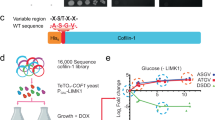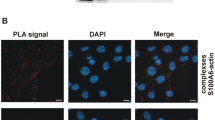Abstract
The 120,000 Mr gelation factor and α-actinin are among the most abundant F-actin cross-linking proteins in Dictyostelium discoideum. Both molecules are rod-shaped homodimers. Each monomer chain is comprised of an actin-binding domain and a rod domain. The rod domain of the gelation factor consists of six 100-residue repetitive segments with high internal homology. We have now determined the three-dimensional structure of segment 4 of the rod domain of the gelation factor from D. discoideum using NMR spectroscopy. The segment consists of seven β-sheets arranged in an immunoglobulin-like (Ig) fold. This is completely different from the α-actinin rod domain which consists of four spectrin-like α-helical segments. The gelation factor is the first example of an Ig-fold found in an actin-binding protein. Two highly homologous actin-binding proteins from human with similar sequences to the gelation factor, filamin and a 280,000 Mr actin-binding protein (ABP-280), share conserved residues that form the core of the gelation factor repetitive segment structure. Thus, the segment 4 structure should be common to this subfamily of the spectrin super-family. The structure of segment 4 together with previously published electron microscopy data, provide an explanation for the dimerization of the whole gelation factor molecule.
This is a preview of subscription content, access via your institution
Access options
Subscribe to this journal
Receive 12 print issues and online access
$189.00 per year
only $15.75 per issue
Buy this article
- Purchase on Springer Link
- Instant access to full article PDF
Prices may be subject to local taxes which are calculated during checkout
Similar content being viewed by others
References
Eichinger, L. et al. Mechanical perturbation elicits a phenotypic difference between Dictyostelium wild-type cells and cytoskeletal mutants. Biophys. J. 70, 1054–1060 (1996).
Cunningham, C.C. et al. Actin-binding protein requirement for cortical stability and efficient locomotion. Science 255, 325–327 (1992).
Noegel, A.A., Rapp, S., Lottspeich, F., Schleicher, M. & Stewart, M. The Dictyostelium gelation factor shares a putative actin binding site with α-actinins and dystrophin and also has a rod repetitive segment containing six 100-residue motifs that appear to have cross-beta conformation. J. Cell Biol. 109, 607–618 (1989).
Yan, Y. et al. Crystal structure of the repetitive segments of spectrin. Science 262, 2027–2030 (1993).
Davison, M.D., Baron, M.D., Critchley, D.R. & Wootton, J.C. Structural analysis of homologous repeated repetitive segments in α-actinin and spectrin. Int. J. Biol. Macromol. 11, 81–90 (1989).
Gorlin, J.B. et al. Human endothelial actin-binding protein (ABP-280, nonmuscle filamin): A molecular leaf spring. J. Cell Biol. 111, 1089–1105 (1990).
Hartwig, J.H. in Protein profile vol. 2, p.739–747, Academic Press, N.Y. (1995)
Stendahl, O.I., Hartwig, J.H., Brotschi, E.A. & Stossel, T.P. Distribution of actin-binding protein and myosin in macrophages during spreading and phagocytosis. J. Cell. Biol. 84, 215–224 (1980).
Carboni, J.M. & Condeelis, J.S. Ligand-induced changes in the location of actin, myosin, 95 K (α-actinin), and 120 K protein in amoebae of Dictyostelium discoideum. J. Cell Biol. 100, 1884–1893 (1985).
Condeelis, J. et al. Actin polymerisation and pseudopod extension during amoeboid chemotaxis. Cell Motil. Cytoskel. 10 77–90.
Condeelis, J., Vahey, M., Carboni, J.M., DeMey, J. & Ogihara, S. Properties of the 120,000- and 95,000-dalton actin-binding proteins from Dictyostelium discoideum and their possible functions in assembling the cytoplasmic matrix. J. Cell Biol. 99, 119s–126s (1984).
Kay, L.E., Torchia, D.A. & Bax, A. Backbone dynamics of proteins as studied by 15N inverse detected heteronuclear NMR spectroscopy: Application to staphylococcal nuclease. Biochemistry 28, 8972–8979 (1989).
Farrow, N.A. et al. Backbone dynamics of a free and a phosphopeptide-complexed Src homology 2 repetitive segment studied by 15N NMR relaxation. Biochemistry 33, 5984–6003 (1994).
Clore, G.M., Driscoll, P.C., Wingfield, P.T. & Gronenborn, A.M. Analysis of the backbone dynamics of interleukin 1β using two-dimensional inverse detected he teronuclear 15N-1H NMR spectroscopy. Biochemistry 27, 7387–7401 (1990).
Clubb, R.T. et al. Backbone dynamics of the oligomerization repetitive segment of p53 determind from 15N NMR relaxation measurements. Protein Sci 3, 855–862 (1995).
Zink, T. et al. Structure and dynamics of the human granulocyte colony-stimulating factor determined by NMR spectroscopy. Loop mobility in a four-helix-bundle protein. Biochemistry 33, 8453–8463 (1994).
Wüthrich, K. NMR of proteins and nucleic acids. New York: Wiley (1986).
Spera, S. & Bax, A. 1991. Empirical correlation between protein backbone conformation and Cα and Cβ 13C nuclear magnetic resonance chemical shifts. J. Am. Chem. Soc. 113, 5490–5492 (1991).
Wishart, D.S., Sykes, B.D. & Richards, F.M. Relationship between nuclear magnetic resonance chemical shift and protein secondary structure. J. Mol. Biol. 222, 311–333 (1991).
Holak, T.A., Gondol, D., Otlewski, J. & Wilusz, T. Determination of the complete 3-dimensional structure of the trypsin-inhibitor from squash seeds in aqueous-solution by nuclear magnetic-resonance and a combination of distance geometry and dynamical simulated annealing. J. Mol. Biol. 210, 635–648 (1989).
Brünger, A.T. & Nilges, M. Computational challenges for macromolecular structure determination by X-ray crystallography and solution nmr spectroscopy. Q. Rev. Biophys. 26, 49–125 (1993).
Harpaz, Y. & Chothia, C. Many of the immunoglobulin superfamily domains in cell adhesion molecules and surface receptors belong to a new structural set which is close to that containing variable domains. J. Mol. Biol. 238, 528–539 (1994).
Bork, P., Holm, L. & Sander, C. The immunoglobulin fold, structural classi fication, sequence patterns and common core. J. Mol. Biol. 242, 309–320 (1994).
Tabor, S. Protein expression using the T7 RNA polymerase/promoter system. In Current Protocols in Molecular Biology (Ausubel, F.A. et al. eds.), Greene Publishing and Wiley Interscience, New York, 16.2.1–16.2.11 (1990).
Hoffman, D.W. & Spicer, L.D. Isotopic labeling of specific amino acid types as an aid to NMR spectrum assignment of the methione represser protein. In Techniques in protein chemistry II. Villafranca, J.J., Ed., San Diego: Academic Press. 409–419 (1991).
Muchmore, D.C., Mclntosh, L.P., Russell, C.B., Anderson, D.E. & Dahlquist, T.W. Expression and nitrogen-15 labeling of proteins for proton and nitrogen-15 nuclear magnetic resonance. Meth. Enzym. 177, 44–73 (1989).
Clore, G.M. et al. Overcoming the overlap problem in the assignment of 1H NMR spectra of larger proteins by use of three-dimensional heteronuclear 1H-15N Hart man-Hahn-multiple quantum coherence and nuclear Overhauser-multiple quantum coherence spectroscopy: application to interleukin 1β. Biochemistry 28, 6150–6156 (1989).
Bax, A. & Davis, D.G. MLEV-17-Based two-dimensional homonuclear magneti zation transfer spectroscopy. J. Magn. Reson. 65, 355–360 (1985).
Jeener, J., Meier, B.H., Bachman, P. & Ernst, R.R. Investigation of exchange processes by two-dimensional NMR spectroscopy. J. Chem. Phys. 71, 4546–4553 (1979).
Guèron, M., Plateau, P. & Decorps, M. Solvent signal suppression in NMR. Prog. NMR Spectrosc. 23, 135–209 (1991).
Jahnke, W., Baur, M., Gemmecker, G. & Kessler, H. Improved accuracy of NMR structures by a modified NOESY-HSQC experiment. J. Magn. Reson. B 106, 86–88 (1995).
Muhandiram, D.R., Farrow, N., Xu, G.Y., Smallcombe, S.J. & Kay, L.E. A gradient 13C NOESY-HSQC experiment for recording NOESY spectra of 13C- labeled proteins dissolved in H2O.J. Magn. Reson. B102, 317–321 (1993).
Mori, S., Abeygunawardana, C., Johnson, M.N. & van Zijl, P.C.M. Improved sensitivity of HSQC spectra of exchanging protons at short interscan delays using a new fast HSQC (FHSQC) detection scheme that avoids water saturation. J. Magn. Reson. B 108, 94–98 (1995).
Farrow, N.A. et al. Backbone dynamics of a free and a phosphopeptide-complexed Src homology 2 domain studied by 15N NMR relaxation. Biochemistry 33, 5984–6003 (1994).
Cieslar, C., Ross, A., Zink, T. & Holak, T.A. Efficiency in multidimensional NMR by optimized recording of time point-phase pairs in evolution periods and their selective linear transformation. J. Magn. Reson. B 101, 97–101 (1993).
Grzesiek, S. & Bax, A. Improved 3D triple-resonance NMR techniques applied to a 31 kDa protein. J. Magn. Reson. 96, 432–440 (1992).
Sklendr,V., Piotto, M., Leppik, R. & Saudek, V. Gradient-tailored water suppression for 1H-15NHSQC experiments optimized to retain full sensitivity. J. Magn. Reson. A 102, 241–245 (1993).
Grzesiek, S. & Bax, A. Correlating backbone amide and side chain resonances in larger proteins by multiple relayed triple resonance NMR. J. Am. Chem. Soc. 114, 6291–6293.
Kay, L.E., Xu, G-Y., Singer, A.U., Muhandiram, D.R. & Foreman-Kay, J.D. A gradient-enhanced HCCH-TOCSY experiment for recording side-chain 1H and 13C correlations in H2O samples of proteins. J. Magn. Reson. B 101, 333–337 (1993).
Hyberts, S.G., Mäki, W. & Wagner, G. Stereospecific assignments of side-chain protons and characterization of torsion angles in Eglin c. Eur. J. Biochem. 164, 625–635 (1987).
Wagner, G. et al. Protein structures in solution by NMR and distance geometry. The polypeptide fold of the basic trypsin inhibitor determined using two different algorithms, DISGEO and DISMAN. J. Mol. Biol. 196, 611–639 (1988).
Vuister, G.W. & Bax, A. Quantitative J correlation: a new approach for measuring homonuclear three bond J(HN-Hα) coupling constants in 15N-enriched proteins. J. Am. Chem. Soc. 115, 7772–7777 (1993).
Seip, S., Balbach, J. & Kessler, H. Determination of backbone conformation of isotopically enriched proteins based on coupling constants. J. Magn. Reson. B 104, 172–179 (1994).
Marion, D. & Wüthrich, K. Application of phase sensitive two dimensional correlated spectroscopy (COSY ) for measurements of 1H-1H spin-spin coupling constants in proteins. Biochem. Biophys. Res. Commun. 113, 967–974 (1983).
Nicholls, A., Sharp, K. & Honig, B. Protein folding and association: insights from the interfacial and thermodynamic properties of hydrocarbons. Proteins 11, 281–296 (1991).
Insight II, Release 95.0, Biosym/MSI, San Diego (1995).
Author information
Authors and Affiliations
Rights and permissions
About this article
Cite this article
Fucini, P., Renner, C., Herberhold, C. et al. The repeating segments of the F-actin cross-linking gelation factor (ABP-120) have an immunoglobulin-like fold. Nat Struct Mol Biol 4, 223–230 (1997). https://doi.org/10.1038/nsb0397-223
Received:
Accepted:
Issue Date:
DOI: https://doi.org/10.1038/nsb0397-223
This article is cited by
-
Diverse phenotypic consequences of mutations affecting the C-terminus of FLNA
Journal of Molecular Medicine (2015)
-
Filamin structure, function and mechanics: are altered filamin-mediated force responses associated with human disease?
Biophysical Reviews (2011)
-
Structure of three tandem filamin domains reveals auto-inhibition of ligand binding
The EMBO Journal (2007)
-
The folding pathway of a fast‐folding immunoglobulin domain revealed by single‐molecule mechanical experiments
EMBO reports (2005)
-
A mechanical unfolding intermediate in an actin-crosslinking protein
Nature Structural & Molecular Biology (2004)



